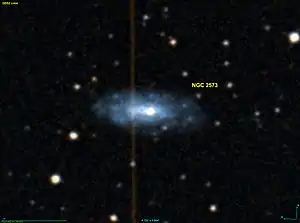NGC 2573
NGC 2573 (also known as Polarissima Australis[1]) is a barred spiral galaxy located in the constellation Octans, discovered in 1837 by John Herschel.[2] It is the closest NGC object to the South Celestial Pole.[1]
| NGC 2573 | |
|---|---|
 NGC 2573 | |
| Observation data (J2000 epoch) | |
| Constellation | Octans |
| Right ascension | 01h 41m 38.012s [1] |
| Declination | −89° 20′ 04.267″ [1] |
| Characteristics | |
| Type | Sb |
| Apparent size (V) | 0.85′ × 0.34′ [1] |
| Notable features | Closest NGC object to the South Celestial Pole. |
| Other designations | |
| NGC 2573, PGC 6249, ESO 1-1 | |
See also
- NGC 3172 - the closest NGC object to the North Celestial Pole.
References
- "NGC 2573". sim-id. Retrieved 2020-05-29.
- "New General Catalog Objects: NGC 2550 - 2599". cseligman.com. Retrieved 2020-05-30.
External links
- SIMBAD: NGC 2573 -- Galaxy
- NGC 2573 on WikiSky: DSS2, SDSS, GALEX, IRAS, Hydrogen α, X-Ray, Astrophoto, Sky Map, Articles and images
This article is issued from Wikipedia. The text is licensed under Creative Commons - Attribution - Sharealike. Additional terms may apply for the media files.
